Research

Kelappaji College of Agricultural Engineering and Technology is actively involved in research in the various disciplines soil and water engineering, Farm machinery and Post harvest technology and agricultural processing. The various departments of the college are Land & Water Resources and Conservation Engineering, Irrigation and Drainage Engineering and the department of Supportive and Allied Courses. Farm Power and Machinery, Post Harvest Technology and Agricultural Processing The research has been concentrated on the thrust areas identified by the university. The research proposals are approved only after presentations in the concerned research co ordination groups and Faculty research committee. The major research projects are the schemes operated under external funding. The major funding agencies are the ICAR and the Government of Kerala.
The students of the undergraduate and post graduate programmes undertake research projects as part of the curriculum. Undergraduate projects are aimed to introducing the young engineers to the field of applied engineering research. Post graduate research forms a major part of the PG programme. Post graduate research funding is by the Kerala agricultural university and part of the expenses is met from external funded projects if the student projects form a part of that scheme. The post graduate research in Soil and water engineering field are taken up in watershed management, Precision farming, micro irrigation, remote sensing and geographical information system.
Department Projects
- Delineation, prioritization and preparation of a detailed project report for the development of micro watersheds of four
different block panchayaths of Malappuram District. - Selection and design of groundwater recharge measures suitable for augmenting well yield of Jalanidhi community water supply schemes
An initiation to construct a sub surface dike across river Bharathapuzha to improve the groundwater potential. - Project report based on a pilot study to improve surface and groundwater potential and for water saving irrigation methods.
- Drip and fertigation studies on vegetables
- Experiments on protected cultivation
- Experiments on influence of tillage practices on soil physical properties
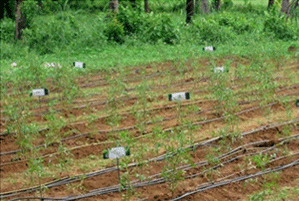

Farm machinery research is taken up for development of machinery for special Kerala situations of Kuttanad, Pokkali and Kaippad, Testing and improvement of existing machinery and development of machinery for different farm operations. Development of technology for processing of crops, development of machinery for special operations such as seed extraction, peeling of ginger, nutmeg decorticator, banana chipping, value addition to crops through processing and product diversification are the major researches under post harvest technology and agricultural processing.
Machineries developed in the Department of Post Harvest Technology and Agricultural Processing
Pineapple Peeler, corer cum slicer
This machine is for peeling, coring and slicing of pineapple is recommended for the restaurants and for canning industry. The out put capacity is 93kg/hr.
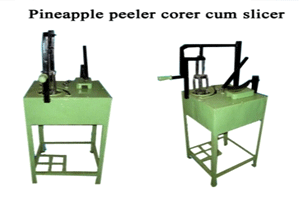
Ashgourd seed extractor
It helps to remove seed without affecting the germination efficiency. Seed extraction was done by moving the flexible shaft inside the ashgourd fruit with hand. Germination efficiency is 90% with an extraction efficiency 98%.Power requirement is 0.5hp.pacity is 80kg/hr
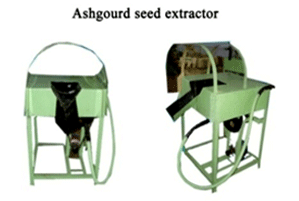
Pepper Thresher
It is used for separating the green pepper from the spikes . The peg tooth and spikes are welded on the shaft used for separating pepper from the spikes.Power requirement is 0.5hp,output capacity is 600kg/hr. Unit cost is Rs 40000/-
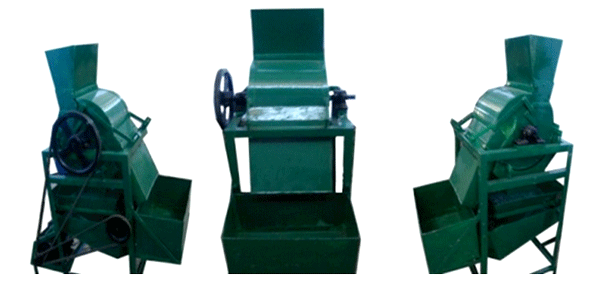
External Aided Projects
AICRP on Farm Implements and Machinery
Location: Kelappaji College of Agricultural Engineering and Technology, Tavanur Function: The scheme was formulated to conduct feasibility tests on farm implements and machinery under various agro-climatic conditions with the following objectives:
- To identify the present farm mechanization gaps and future needs for improved farm equipment on the basis of objective analysis of prevailing agro-socio-economic factors for different crops, cropping patterns and agro-climatic regions.
- To conduct feasibility testing on farmers’ field of prototypes of proven designs of farm implements and machinery, selected from different regions for adoption under local conditions with a view to bridge the identified mechanization gaps.
- To educate the farmers about the usefulness of the improved implements and their efficient handling by front line demonstrations.
Identifying Research Problem and their prioritization
Studies are conducted periodically on problems on agricultural sector for formulation of research priority in different agro climatic regions. The research priorities are made on the basis of comments and suggestions from the farmers, agricultural officers, engineers from the department of agriculture and scientists of different regions including problematic areas
Salient Accomplishments
Study on Paddy seeder for pre- germinated seeds
Broadcasting of paddy during pre-monsooon showers (May) is practiced in Palakkad district for first crops season and transplanting is followed in the puddle soil for second and summer seasons. Due to scarcity of water, a machine for sowing paddy seeds in the puddled soil is introduced.

Study on Paddy seeder for dry sowing
For establishing good quality crop with the available soil moisture power operated seeders was introduced.
Evaluation of Mini tiller with attachments for plantation/ horticultural crops
The mini tillers with attachments is found useful for the horticultural and plantations crops like coconut, arecanut, banana, pepper, cashew nut, rubber, vanilla etc. which are being grown as high intensity crops in inter cropping, multi cropping and multi storied cropping systems under homestead agriculture.

Rotavator for plantation/ horticultural crops
Rotovators of power tillers and tractors are commonly used for paddies but not popular in plantation/ horticultural crops. Introduction of rotavator for non conventional crops reduced cost of cultivation and improved income.
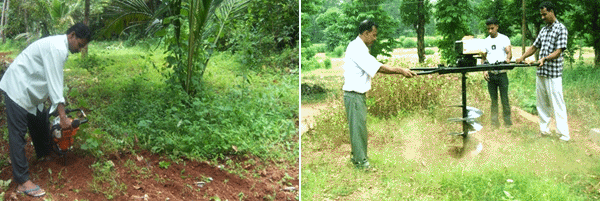
Study on power operated Coconut dehusker
Husking of coconuts is carried out manually using the traditional crow-bar type tool. It needs great skill and the operation is highly dangerous and laborious. Youngsters are not ready to take up the job and scarcity is felt throughout the state. A 3 HP motor operated coconut dehusker was developed and evaluated.
Study on Coconut and arecanut palm tree climbers
Without any gadget traditional climbers harvest coconut and arecanut by climbing in most dangerous way. These trees are highly slippery and regular deaths are reported. Acute shortage resulted in delay in harvesting of coconut and arecanut. Five different types of harvesting tools were developed and evaluated.
Study on Tractor mounted pulverising roller
The pulverising roller was found suitable to use as puddler for paddy fields.
Study on self propelled hydro tiller
In Kerala, the entire paddy land is ploughed and puddled only by tractors and power tillers. For puddling operation for paddy transplanting in the traditional paddy lands a simple and lighter floating type self propelled puddler is introduced. This also reduced the initial investment and operational expenditure.
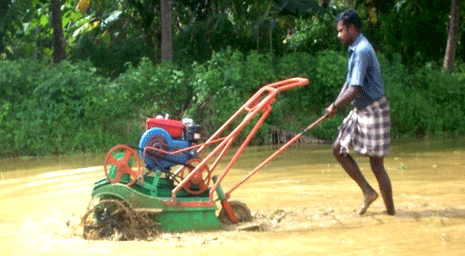
Study on tractor operated post hole diggers
The tractor operated JNP, FII and Gomadhi makes of post hole diggers having auger diameter with 150, 180, 220, 300, 450 and 600 mm were evaluated in different soil conditions. Farmers used the post hole diggers to make pits suitable for planting coconut, areca nut, rubber seedlings, planting banana suckers and also for erecting fencing pillars. Damages to the central tip and the double starting edges were noted in laterite soils. Portable engine operated hole diggers were also used for planting many horticultural, plantation, medicinal and ornamental seedlings in the laterite soils.
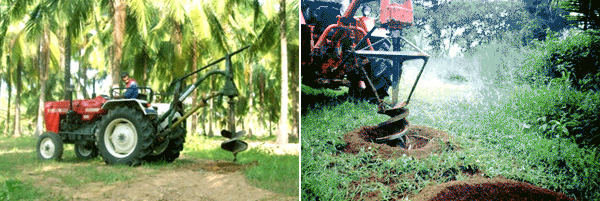
Study of self propelled rice transplanter
Ten types of transplanters were evaluated. They are: IRRI 5-row transplanter, IRRI 6-row transplanter, APAU power tiller mounted 8-row transplanter, Improved tiller mounted transplanter (KAU) and Chinese Yanji 8-row transplanter, Walk behind transplanterKukje, AIC, Tong-Yang, Four wheel Yanmar and LG transplanters. The method of mat seedling preparation was standardized to suit different agro-ecological conditions. Trainings were given to the dealers and field operators regarding the improved mat preparation method and transplanting. Feasibility trials and extensive transplanting in the farmers fields were done in four districts. Savings of 80% labour, 56% cost, 40% time and 30% seed paddy were obtained. An increase in yield up to 18% compared to manual transplanting was also noted. Few hundred rice transplanters are successfully used in Kerala.

Evaluation of mini paddy combine harvester
The following 13 makes of the combine harvesters were evaluated. They are: Mitsubishi 18 hp mini combine, Kukje 18 hp head feed combine, Kukje 35 hp head feed combine, Kubota 48 hp rice combine, Claas Crop Tiger 54 hp grain tank combine, Kukje DKC-515 50 hp hopper combine, Kukje DKC-685 64 hp tank combine, Tractor 60 hp wheel type combine, Swaraj 55 hp crawler type combine, Preet 60 hp crawler type combine, Dae-Dong head feed combine, Redlands Champion TRF-15 combine, and Kubota DC 68G combine. The ChineeseSifang mini combine was also evaluated for the first time and was found to perform unsatisfactorily due to failure of its different components. Wheel type combine harvesters were found not suitable, because of traction problem, where as the track type combines worked well even in muddy field. The Dae-Dong head feed combine was introduced first time in Kerala during March 2010. It was evaluated in two seasons in four locations and was found to perform better compared to other combines in the highly sinking fields with heavy weed infestation.
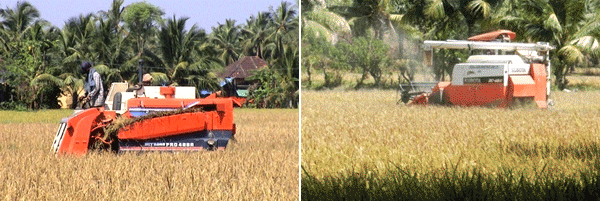
Study on tractor operated zero till seed drill
The tractor operated zero till seed drill was evaluated for seed rate, field capacity and fuel consumption. The fluted roller mechanism was calibrated to get the maximum field performance. The agronomically recommended seed rate for cow pea, green gram and paddy are 50-60 kg/ha, 20-25 kg/ha, and 80-90 kg/ha, respectively, where as the seed rate obtained during performance evaluation were 58.71 kg/ha, 22.53 kg/ha and 74.75 kg/ha. The field capacity obtained were 0.426 ha/h, 0.409 ha/h and 0.393 ha/h respectively and the fuel consumption were 0.390 l/h, 0.362 l/h and 0.365 l/h, respectively. The line sowing improved the yield and made weeding easier. The soil moisture available after the paddy harvest was utilized for seed germination and growth till the onset of summer paddy. Improvement of seed metering mechanism is needed for sowing summer paddy.
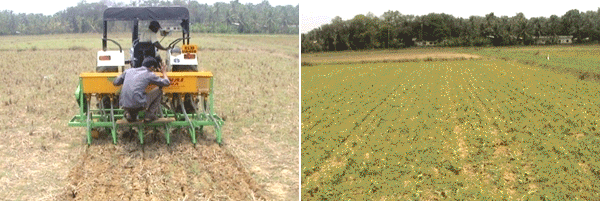
Study on raised bed planter
The tractor operated raised bed planter was evaluated for seed rate, field capacity and specific fuel consumption. Performances of the raised bed planter for cow pea, green gram and dry paddy were done using internal double run mechanism. Performance of the raised bed planter for cow pea and green gram using inclined plate mechanism was with field capacity-0.476 ha/h for cow pea and 0.470 ha/h for green gram, and Fuel consumption-0.343 l/h for cow pea and 0.354 l/h for green gram.
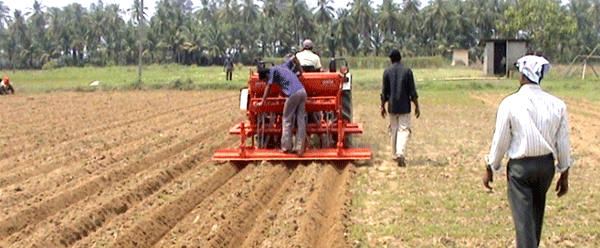
Evaluation of tractor operated paddy straw baler
ClaasMarkant straw baler was evaluated at Ponnamudha of Thrissur in 8.5 ha. The length of the bale can be adjusted for 0.4 -1.1 m. The cost of straw is Rs.8/kg. The weight of a bale of length 60 cms ranges from 20-22 kg. Redlands baler was operated at instructional farm of KCAET, Tavanur in 4 ha and 2.6 ha at Cherpu, Thrissur. The round straw bale formed weighs around 18 kg. Custom hiring rate of tractor plus baler is Rs.10 per bale. Labour charge for a tractor operatded baler is Rs.600 per day of 8 working hours. Farmers are satisfied with the performance of straw balers, as the straw adds to the income of the farmers. Reaper cum knotter of Redlands was also evaluated at instructional farm of KCAET in an area of 3 ha. The pick up width of the machine is 500 mm.The average field capacity was found to be 0.2 ha/hr. The machine can bale 1000 bales of weight 1.5 kg and is having a specific fuel consumption of 1l/hr.
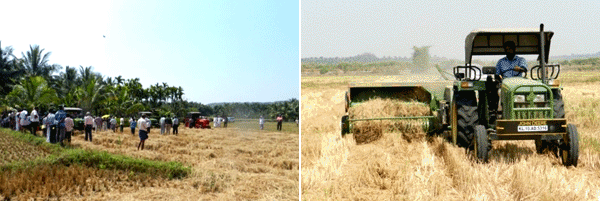
Evaluation of power weeder for low land rice
The Comparative evaluation of Paddy weeder (TNAU Model) with Otake three row paddy weeder, manually operated roto-weeder and cono-weeder were done for 2.3 ha at Instructional farm, KCAET, Tavanur. It was found that Garuda paddy weederis a compact, lower weight user friendly machine, self propelled with floating system. The field capacity of the weeder is 0.038 ha/hr. Otake paddy weeder caused vibrations to the shoulder and it needed optimum level of water in the field for satisfactory operation.
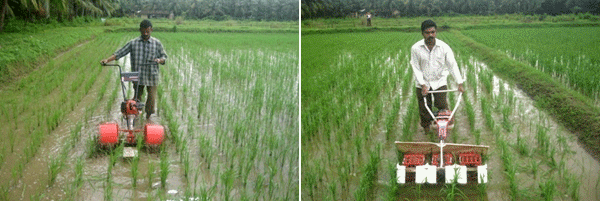
Impact Statement
Right from the beginning in 1980, AICRP on FIM, Tavanur centre has been playing a pioneering role in research, prototype evaluation of machinery suitable for the agro climatic region, promotion of manufacturing through industrial extension and introduction and popularization of improved farm equipment through custom hiring. In the beginning, the farmers were reluctant to accept farm mechanization due to various socio-economical and political issues. The only machines used were the tractor with cage wheels and cultivator and the power tiller with cage wheels. AICRP on FIM had evaluated and introduced many advanced machinery, demonstrated their working at farmers field to make the farmers aware of latest machinery available in the market. The extension activities conducted under the scheme helped farmers to understand the technological and economical benefit of farm mechanization.
The animal power has now been fully replaced by mechanical power. The mechanization level of principal crops has also grown higher as shown in table.
Mechanization level of principal crops of Kerala
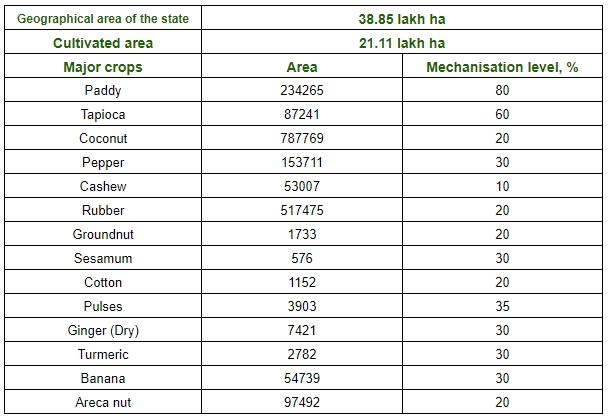
Precision Farming Development Centre, Tavanur
Funded by: National Committee on Plasticulture Applications in Horticulture, New DelhiFaculty and student involvement: The student projects in the graduate level and the masters thesis taken in this line are being helped through this research project. During the practical hours also students are taken to the field to get familiarized with the technologies like micro irrigation, fertigation, protected cultivation etc.
Salient accomplishments in research during 2008-12
Production of quality vegetable seedlings in low tunnels under humid tropic conditions.
Low tunnel structures made of MS rod and MS flat with 100 micron thick UV stabilized polythene sheet as cladding material can be adopted as a low tunnel technology for nursery production. Seedlings raised under low tunnels in Pro- trays gave the best performance. The method can be adopted as a cost effective method for seedling raising.
Fertigation in coconut
The biometric observations showed that fertigation with 80% of the recommended doze of fertilizer are the best treatment for coconut. The yield trend also gives the same result. Fertigation is to be done at monthly intervals with 80 % of the recommended dose of fertilizer. Phophorous is given through basal application in 6 split doses at an interval of 2 months. Nitrogen and Potassium is to be applied throughfertigation. The quantity to be applied for hybrid plants after 2 years of age is 60gm N and 130gm K/plant/month. In low lying areas where the water table is high, fertigation can be done after water table recedes or two applications can be combined.
Water and nutrient management for cucumber grown in naturally ventilated green houses.
Application of neem cake, vermi compost, VAM, along with drip irrigation and silver black mulching gave higher yields for salad cucumber crop inside naturally ventilated greenhouse. A water application rate of 1.5 l/plant/day through drip irrigation was found to be suitable for salad cucumber grown in naturally ventilated greenhouse.
Cultivation of cool season vegetables in Naturally Ventilated GreenHouse(NVGH).
The crop inside the naturally ventilated greenhouse yielded early by three weeks. The quality of the produce as its size and the physiological parameters as biomass production inside the NVGH was significantly higher than that of outside. Almost double yield was observed in case of cabbage and cauliflower respectively from inside the NVGH compared to open field.
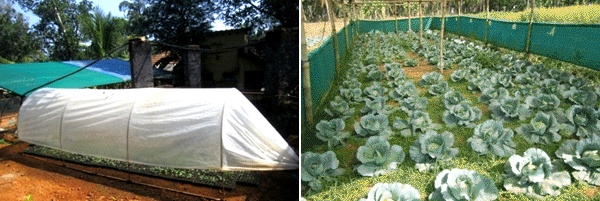
Development of Innovative Farm Mechanization Package for Kerala (DIFM)
Number, location and lead function of various research stations: Department of FPME, KCAET, Tavanur.Process of identifying research problem and their prioritization. Survey and analysis of field problems related to the scarcity of labourers in agriculture field and prioritized as follows:
- To develop need based small agricultural machineries for major crops and vegetables of the State at R&D center at KCAET, Tavanur
- To identify and locate any farm machines/equipments invented/ developed by farmers or local artisans of the country
- Field testing and perfecting these machines for farm use
- Technology transfer and development of prototypes and promotion through small and medium scale industries of the State
- Upgradation of the leading small scale industries in Govt and private Sector to introduce of new generation agricultural machinery and its marketing through reputed agencies
- Intervention in replacement of Petty and Para the age old low efficiency pumping system used in Kuttanad and Kole areas of Kerala
Funding sources: State Planning Board, Govt of Kerala, Thiruvananthapuram Faculty and students involvement in research: The faculties of the dept. of FPME is fully involved in formulating the research programmes and monitoring its work at execution and testing levels.The students are also involved through the project works at B.Tech & M.Tech research programs
Salient accomplishments: The machines were developed for dehusking of coconut, bund formation in Kaipad areas for making nursery in paddy cultivation, coconut palm climberfor easy climbing of coconut, coconut splitter, tender coconut punch and copra separator for small scale farmers, small scale and women friendly equipments such as Coleus Peeler and Thorny bush up rooter, herbicide applicator for removing the weeds from the paddy field at the time of transplantation, Precision agricultural implement for vegetable cultivation, harvesting machines for root crops such as Ginger and coleus, the machines for manure preparation especially the manure from goat faecal and cow dung, an alternative to ‘Petty and Para’, pumping systems is also progressing Dept. of FPME Developed a Digital Database on Agricultural Implements which is helpful to farms to select the correct implements for a particular crop.
Impact statement: The farming sector especially in paddy, coconut, spices and vegetables of the state rejuvenated through selective mechanization adopted by this Department at KCAET.
All India Coordinated Research Project on Post Harvest Technology (AICRP on PHT)
Location: KCAET, Tavanur
Objectives:
- To study the prevailing post harvest practices and identify unit operations, equipment and their components that needs improvement or substitution, adequacy and inadequacy of the prevailing practices.
- To develop and adopt farm level cleaners, graders and driers for mandate crops
- To develop simple processes, low cost equipments and pilot plants for farm or village level processing of food grains, oil seeds and other crops for rural consumptions as well as for selling value added products to semi urban and urban areas for better economic returns.
- To develop simple processes and equipment at farm or village level for better economic utilization of agricultural wastes and by-products as food/ feed/ fuel etc. for increasing profitability of the commodity and income of the farmers.
- To undertake studies on techno-economic feasibility and economical viability of on-farm/ village level processing industries.
- To field evaluate laboratory proven technologies and carry out operational research trials on the developed technologies for villages to identify technical, managerial and social constraints and take remedial measures before releasing for popularization.
- To create post harvest technology consciousness and transfer of proven technologies in selected villages and monitoring its effect on economic and social development.
- To generate income and employment in rural areas through adoption of proven technologies and equipment through establishing agro processing centres.
Date of start: Scheme commenced its operation in October 2004.
Funding agency: ICAR (in the ratio of 75:25)
Mandate crops allotted for the centre: Spices
Research programmes of the centre
- Standardization of vanilla curing.
- Modified Atmosphere Packaging and Storage studies of cured vanilla
- Process development of vanilla oleoresin
- Process development of vanilla extract and vanilla flavouring
- Studies on drying of Pepper
- Development of a Black Pepper Decorticator
- Development of a pilot plant for osmotic dehydration of green pepper
- Development of banana (CV Nendran) peeler for making chips
- Development of HACCP protocol for safe pepper and pepper products
- Adaptive trials on the equipment developed at other centers (Areca nut dehusker) Major achievements of the centre
A. Standardization of vanilla curing
The existing method of curing vanilla beans is by Bourbon method. The improved method developed by this centre is faster, less energy intensive and produces quality output in terms of vanillin content. It is both labour and time saving process. This process is quite economical in compare with the traditional method and can be popularized to Indian vanilla growers since it definitely make improvement in financial status of vanilla farmers, which perhaps can create a positive influence in the state and national economy.
B. Development of a black pepper decorticator
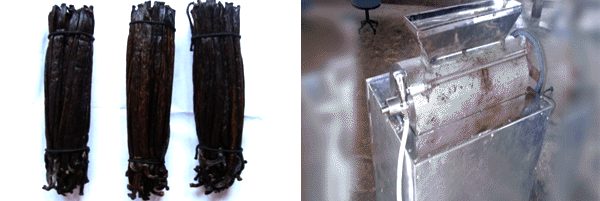
This machine decorticates the presoaked berries by the combined effect of churning and centrifugal action. Water is jetted inside the decorticating drum to enhance the removal of the outer pericarp of the berries. In order to facilitate the efficient decortications, twenty spikes are fixed in staggered arrangement on the shaft.The efficiency of the machine is 92%.Cost of the machine is Rs.35000/-.This machine is also tested with matured green pepper and the efficiency reported as 94%.Capacity of the machine is 40 kg/h.
C. Process and equipment developed for vanilla oleoresin
Based on the laboratory studies, a vanilla oleoresin extraction plant having a capacity of 3 kg was fabricated. It consists of an extractor, condenser and a container for extraction solvent. This machine works on the principle of Soxhlet apparatus. The maximum vanillin content of 3.92% was obtained in hot extraction method using isopropanol with extraction duration of 7 hour
D. Process and equipment for Vanilla Extract and Flavouring
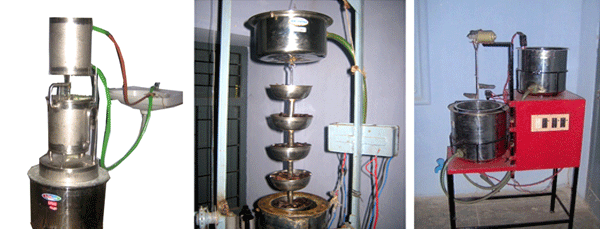
In view of developing an indigenous, cost effective method of extraction of natural vanilla from vanilla planifolia, a prototype percolation type vanilla extractor with ethanol was developed and its performance was evaluated. The pumping, circulation and percolation is carried out for three different concentration .i.e.60%, 30% and 15% and the overall concentration of ethanol would be 35% which is considered optimum as per standards. The capacity of the machine is 500gm and the extraction efficiency is 60% with an evaporative loss of 12.9%.
E. Development of pilot plant for osmotic dehydration of green pepper
Green pepper is an important value-added product prepared from unripe but fully matured pepper berries To assure round the year availability, green pepper could be better dehydrated and stored for a year or more and can be used at will by simple reconstitution. Hence an osmotic dehydration plant for green pepper was developed in this scheme. The secondary stage of drying was done using a tray drier.
Impact
The technology developed under AICRP on PHT was included in the package of practise of the University.
HACCP protocol developed under the AICRP on PHT is being implemented in the spice industries in Wayanad District.
Title of the Project Development of Rotary banana Slicer
Total amount sanctioned : 2.64Lakhs
Funding Agency : KSCSTE
Duration of the projects :1.5 year
Date of Start of the projects : 01.08.2011
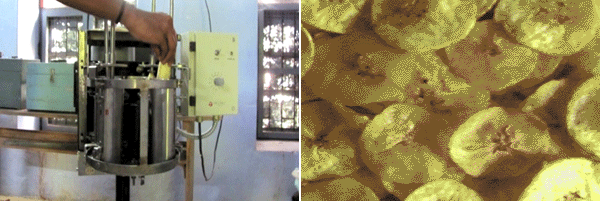
Main objective is to develop a motor operated rotary banana slicer for mechanical slicing of banana and to evaluate its performance. The fabrication of the first model is over and initial testing of the model is completed. This machine will reduce the labour requirement in the banana chip making industry.
Strategies forSustainable Watershed Development for ErnadTaluks-Malappuram district – Hariyali Watershed Project.Funded by District Panchayath, Malappuram.
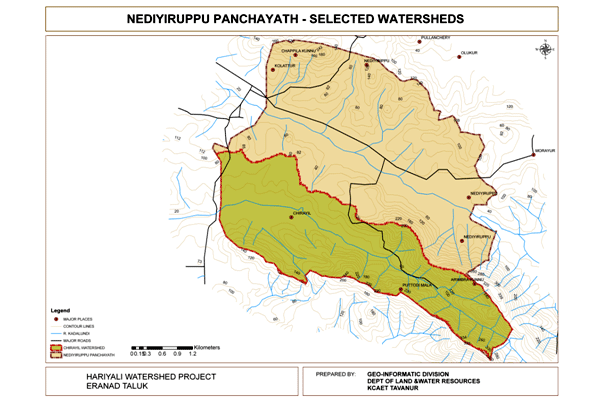
Available base maps and attribute information were collected for the study area, Eranadtaluk, Malappuram district. Completed the GIS digitilization works and generated the maps showing slope, elevation. Land use map has been prepared using satellite imagery. All the micro watersheds have been delineated using SWAT model. Field work for ground truthing and prioritization of the micro watersheds have been done thoroughly. Detailed analytical work to identify the problems of the watersheds had been carried out with the help of SWAT model. After the micro watershed delineation and the problem identification, Detailed Project Report (DPR) for the development of each of the micro watershed has been prepared. The DPR includes detailed thematic maps showing boundary and total area of the watershed, soil, land use, drainage network, ponds, roads and other physical infrastructures. Developmental interventions have been suggested looking into the problems related to the conservation of land and water, augmentation of agricultural production, animal husbandry and value addition of agricultural produces and employment generation. All the interventions have been shown with their spatial location, technical drawing and detailed cost estimates. Many GramaPanchaths have started implementing the recommendations suggested in the master plan.
Evaluation and standardization of a micro sprinkler developed by Sri.Avaran, an innovative farmer- Funded by KSCSTE
Evaluation and standardization of the micro sprinkler were completed. Four different dimensions were standardized for pressure and discharge. Also other parameters like coefficient of uniformity, wetted radius, and coefficient of variation, water distribution characteristics and application depths were also analyzed.




